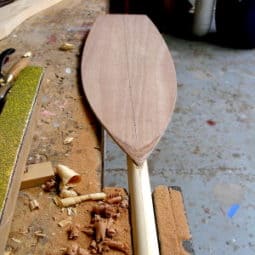This is the normal method for fibreglassing small areas for home boatbuilders – typically using fibreglass tape to hull seams, very common on stitch and glue and plywood boats
Here I document the process of coating the hull and fibreglass taping the chines in one hit.
Integration of different steps in this way is one of the major efficiencies of modern epoxy boatbuilding.
However if simply glass taping the seams and not wanting to coat the surface the same method can be used with the simple change that a coat of epoxy is simply brushed onto the areas where the tape will be placed rather than over the whole surface.
Preparation of the boat hull for coating and fibreglass taping.
The method for fibreglassing hull seams can use the same wet-on-wet approach as for large areas but with a small change to integrate the application of the glass tape. It makes it a very clean and tidy process once you get the idea.
Fill any screw holes, allow the epoxy to cure and sand flat. Radius the edges that the tape will be applied to. A minimum of 3mm (1/8”) is just enough to allow the glass to wrap around without lifting. A bit more is better – but don’t round the edges around the transom at the stern too much – the water wraps round the corner when sailing causing drag.
First Coat of epoxy on the hull and the secret smoothing method
Apply first coat of epoxy to hull (pic below) or just brush it on the areas where you are glass taping.. Note the masking tape to prevent epoxy drips running around the corner onto the deck. The finish can be quite smooth by holding the roller so it can’t turn and lightly and slowly skid it across the surface to pop bubbles and get rid of roller marks – but work from the middle of the length of tape towards the ends not from the ends towards the middle
![]()
With epoxy laid out put the glass tape down with light tension.
.Put glass tape down in wet epoxy (pic below). I should be wearing gloves.

Detail of glass along transom.(pic below). Use the roller or a cut down disposable brush (bristles not longer than 25mm (1”) to work epoxy into the glass tape – it goes clear when the epoxy has wetted it out correctly.

An example of wetting out (pic below) – the glass along transom is now wetted out and becomes clear. The glass on the corner is being trimmed to length.

Add more resin only if absoulutely necessary to make glass go clear
Roller method for wetting out (getting the resin into the glass).

When first coat goes tacky roll on a new coat
Three coats epoxy are normal for full waterproofness.
Tacky is when rest your (gloved) on the surface and then lift it you can feel it peeling off the surface with a little bit of resistance.
Finished taping and second coat is put on when first gets tacky – roll the epoxy out well so as to not add too much weight – but roll a little bit extra on the tape – too much and it will run down the side.

When the boat hull is tacky again roll the third and final coat.
When epoxy goes tacky apply a third thin coat and skid the roller to give a smooth finish.
If the weave pattern is still visible in the glass tape roll another coat to fill up the weave when the epoxy goes tacky again.
Leave epoxy to cure.
Tidy up the next day with a sharp edged tool used carefully to remove “most” of the glass tape edge.
Put talcum powder on your hands and wrists and after start your shower in cold water to remove all the glass dust and shavings before changing to hot.
Don’t wait long to clean up the glass edges. With the epoxy still a bit green/cheesy it is much easier.
The best tools are a choice of
- Cabinet scraper – lots of stuff on the net on how to sharpen and use.
- A blade from a plane or spokeshave used like a cabinet scraper
- A spokeshave with a skewed blade set to cut on one side only.
One neat trick is to build up some masking tape on the edge of the tool that will be working over the plywood so the corner doesn’t dig in.
For a spokeshave – set a spokeshave fine and get rid of the edge of the glass tape. Keep the body of the spokeshave over the glass but set the blade with a tiny bit of depth on the edge side but no depth on the other.
Work carefully and slowly. If you are making mistakes, have something to eat or a walk.
Sanding technique with power sanders to get rid of the tape edge on your boat hull
Then sand the glass tape using the random orbit sander and 120 grit paper. Keep the edge of the sander lined up with the edge of the glass, but keep the sander body over the tape. Angle the sander – concentrate a bit of weight on the side of the sander over the tape edge and keep the rest of the sander over the surface of the tape.
Finish off by sanding the rest of the bottom to a matte finish (no gloss) but don’t go through the epoxy to the timber.
Generally I brush a couple of thin (ie thinly applied – never use thinners or solvents with epoxy) coats onto any areas where I go through to the wood – allow that section to cure and give a light sand – making sure I blend the edges of the brushed area.



















